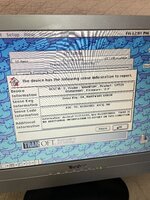luRaichu
Well-known member
I thought it would be a good idea to start a thread for my own vintage Mac adventures, which I hope will include a PB 180 in the future (although that seems slim now).
I’m currently still working on my trash-to-treasure LC, trying to revive the internal SCSI hard drive. It doesn’t mount, (it’s detected by SCSI probe) and SCSI director gives some scary news:

I did carefully open the drive soon after it failed last Summer, it looked good internally to me. In this photo I have the parity jumper removed so maybe that’s it??
I’m currently still working on my trash-to-treasure LC, trying to revive the internal SCSI hard drive. It doesn’t mount, (it’s detected by SCSI probe) and SCSI director gives some scary news:

I did carefully open the drive soon after it failed last Summer, it looked good internally to me. In this photo I have the parity jumper removed so maybe that’s it??
